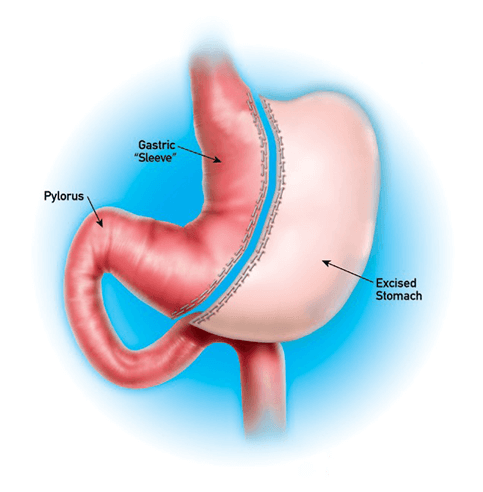Surgical Options
Weight loss surgery changes the way your digestive system works. Center for Bariatric Surgery’s clinical staff will discuss the different procedures with you and help determine which one best fits your particular goals and situation.
Laparoscopic Roux-en-y Gastric Bypass
Gastric bypass is a surgical procedure that alters the process of digestion.
Roux-en-Y gastric bypass, the most commonly performed bariatric procedure, is both malabsorptive and restrictive. This surgery can result in two-thirds of excess weight loss within two years. The procedure involves reconstructing the stomach to create a small pouch that holds less food and then shaping a portion of the small intestine into a “Y”. The “Y” portion of intestine is then connected to the stomach pouch so that when food is being digested it travels directly into the lower part of the small intestine, bypassing the first part of the small intestine (called the duodenum) and the first part of the second section of the small intestine (called the jejunum). The effect of bypassing these sections of the intestine is to restrict the amount of calories and nutrients that are absorbed into the body.
The Roux-en-Y gastric bypass may be performed with a laparoscope rather than through an open incision in some patients. This procedure uses several small incisions and three or more laparoscopes – small thin tubes with video cameras attached – to visualize the inside of the abdomen during the operation. The surgeon performs the surgery while looking at a TV monitor. A laparoscopic method allows the physician to make a series of much smaller incisions. Laparoscopic gastric bypass can sometimes reduce the length of hospital stay, the amount of scarring, and may result in a quicker recovery than an open procedure.
Laparoscopic Sleeve Gastrectomy
Sleeve gastrectomy is a procedure that induces weight loss by restricting food intake. With this procedure the surgeon removes approximately 60 percent of the patient’s stomach laparoscopically so that the stomach takes the shape of a sleeve, thereby decreasing the appetite as well as creating an earlier sense of fullness for the patient.

According to the American Society of Metabolic and Bariatric Surgeons, this approach involves performing a less invasive procedure that reduces weight to a safer level and improves overall medical condition first; then a more complex, definitive procedure is performed once the operative risks of the patient decrease significantly due to the initial weight loss, if so desired. These less invasive steps have included the “sleeve gastrectomy,” as a possible interim step before a Roux-en-y Gastric Bypass is performed, on some occasions. The sleeve gastrectomy is now established as the first stage of a two stage procedure as well as a single stage procedure depending on the medical needs of the patient. The sleeve gastrectomy does not require the implantation of a foreign body or rearrange the intestinal tract.
Similar to the Roux-en-Y bypass the Gastric Sleeve is expected to have a length of stay in the hospital of approximately 1-2 days. Operating room time can be expected to be around 190 minutes, similar to that of a Roux-en-Y.
Laparoscopic Adjustable Gastric Band
Gastric banding surgery is a type of Bariatric surgery (weight loss surgery) procedure performed to limit the amount of food a person can eat.
In this procedure involves attaching an inflatable band around the top portion of the stomach and tightening it like a belt to form a small pouch that serves as a new, much smaller stomach that can hold about one ounce of food. The food from this “new” stomach empties into the closed-off portion of the stomach and then resumes the normal digestive process. Over time, the pouch can expand to hold two to three ounces of food.


After the procedure, the diameter of the band around the stomach can be adjusted by a physician by adding or removing saline (salt water). Because the size of the stomach is reduced so dramatically, this type of procedure is referred to as a restrictive procedure.